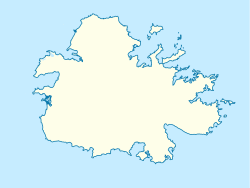History
Fort Berkeley was built in 1704, on a peninsular strip of land at the entrance to English Harbour. [1] [3] It was originally a simple fortification, consisting of an enclosed area with a gate and guardhouse. [4] A construction of the Antiguan government, the fort was manned by government hires rather than by soldiers. [1]
In 1745, Fort Berkeley was significantly expanded and upgraded with the development of English Harbour's Naval dockyard. [3] The first half of the new battery was built by the Antiguan government. The second half was built by the Royal Navy under Commodore Charles Knowles. [3] According to Knowles, he commissioned the construction's completion after the Antiguan government refused to continue funding the construction. [3] As a result, the two halves of the battery were built with two different architectural and tactical styles. [3] The British government criticized and removed Commodore Knowles from his post for involving the British in the completion of the battery, which they saw as an Antiguan government responsibility. [3]
After its expansion in the 1740s, Fort Berkeley had a magazine and a guardhouse, and was armed with 29 guns: 19 mounted cannons and an additional battery of 10 guns belonging to the Navy. [3] Additionally, the fort had an iron chain that was strung across the harbour's entrance from Fort Charlotte. [4] The chain could be raised to prevent vessels from entering the harbour. [4]
In 1783, the Antiguan government turned the fort over to the British Navy. [3] In 1807, the British added the gunpowder magazine to the fort. [1] There is evidence that Fort Berkeley was used as a quarantine station. [4] In 1843, an earthquake destroyed most of Fort Berkeley's original wall. [5]
The current remains of Fort Berkeley include the powder magazine, guard house, crenelated walls, and a canon from 1805 in its original position. [3] The fort is accessible via a short nature trail called Fort Berkeley Trail. [1] [4]
In 1984, Fort Berkeley became part of Nelson's Dockyard National Park. [6] [7] In 2016, it became part of a UNESCO World Heritage Site, as UNESCO recognized the English Harbour dockyard and the surrounding military archaeological sites together as "The Antigua Naval Dockyard and Related Archaeological Sites." [8] [9]
This page is based on this
Wikipedia article Text is available under the
CC BY-SA 4.0 license; additional terms may apply.
Images, videos and audio are available under their respective licenses.






